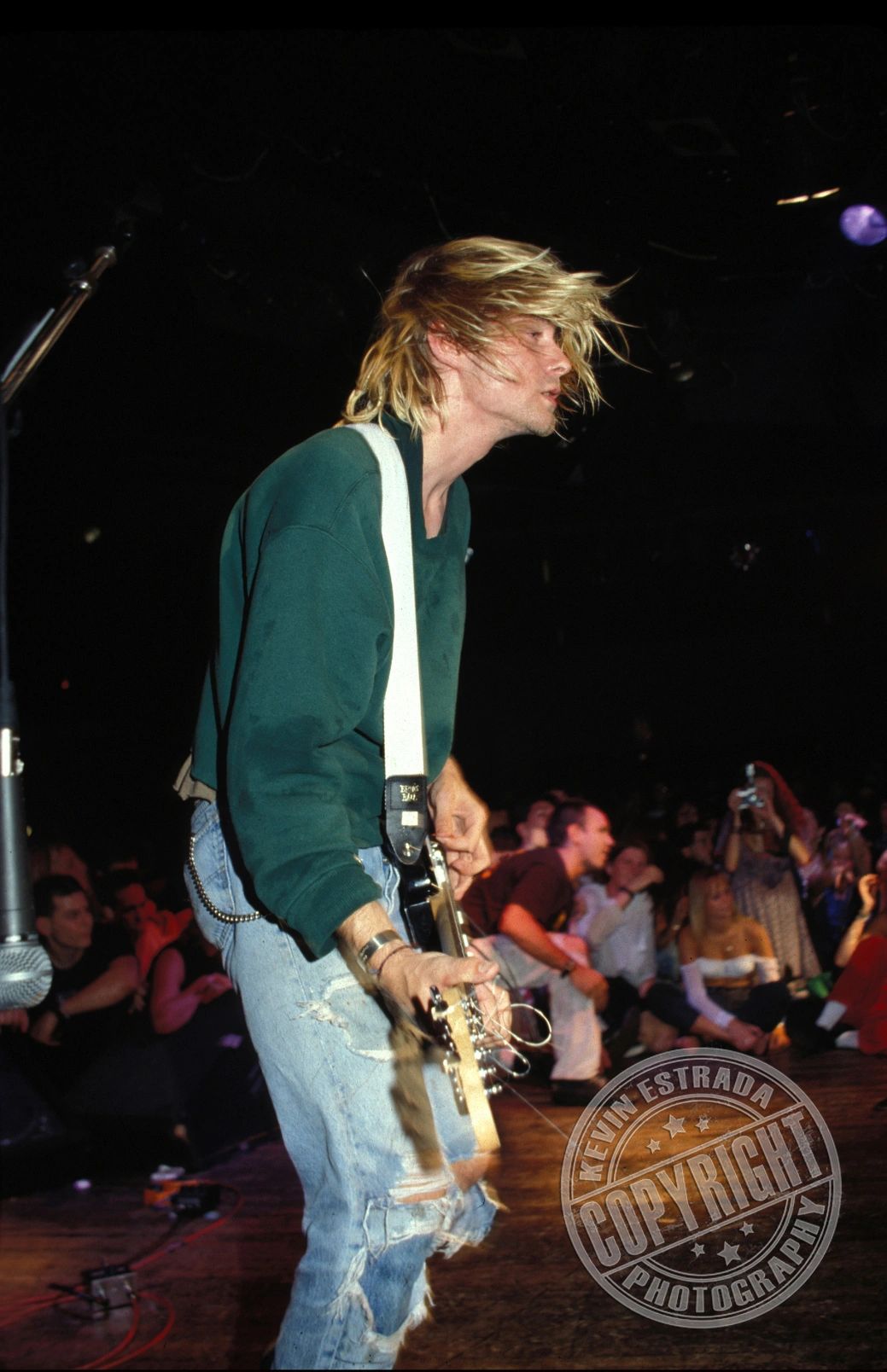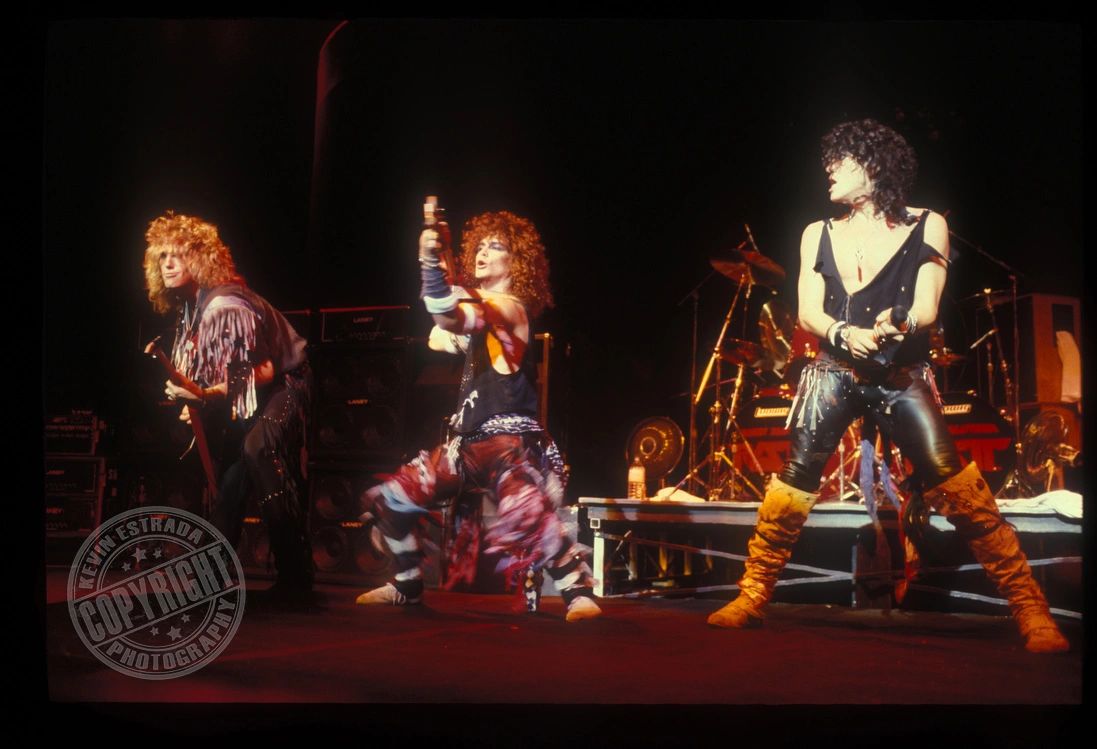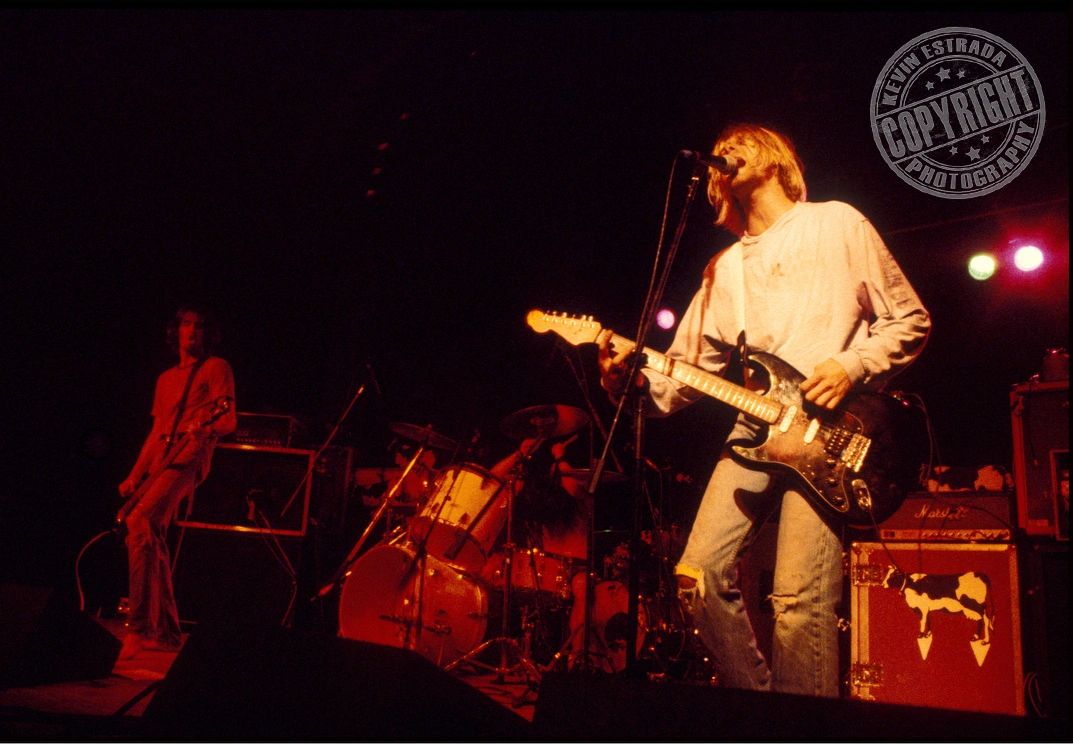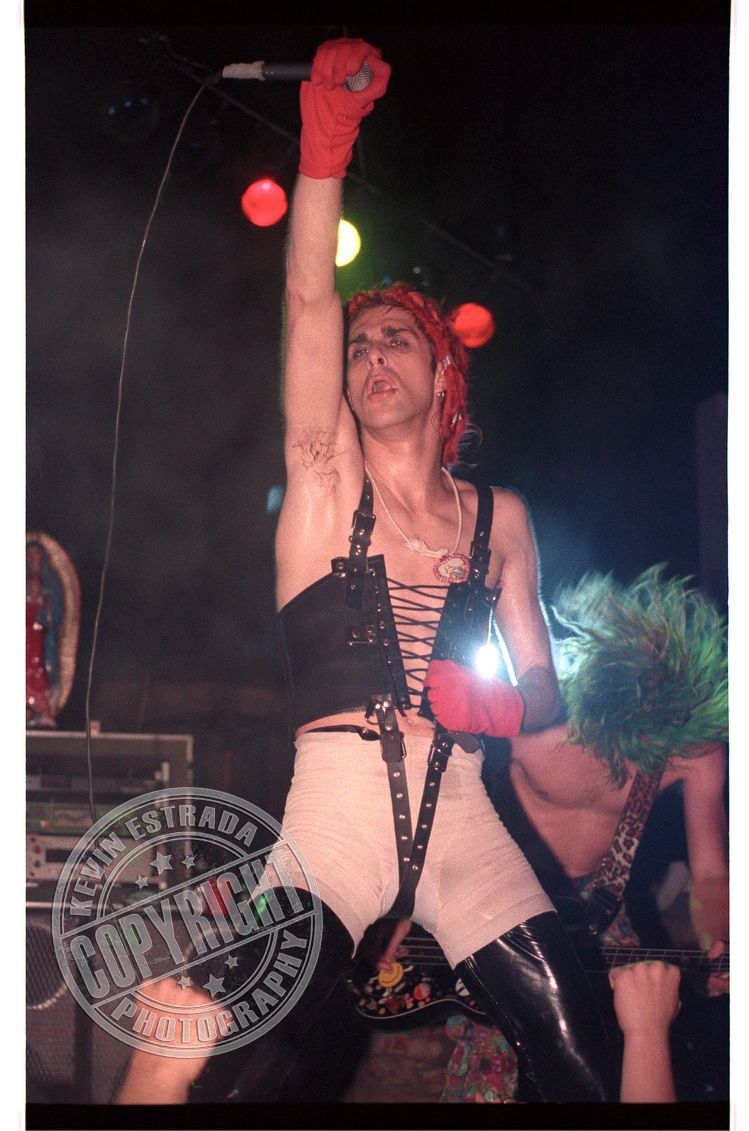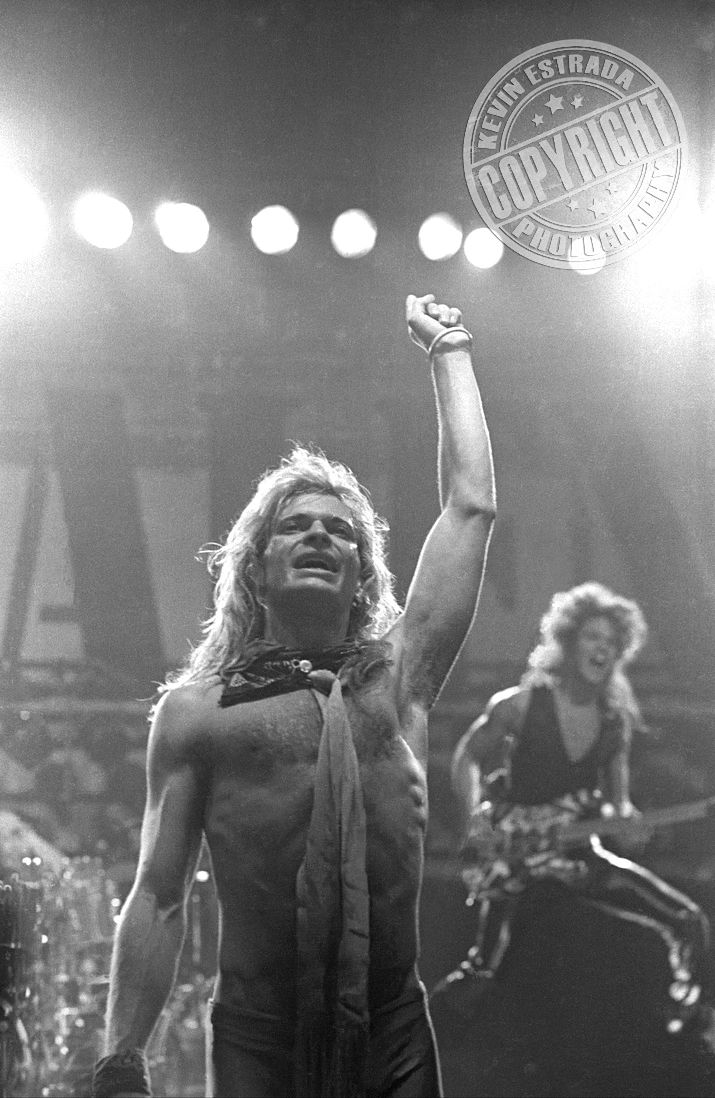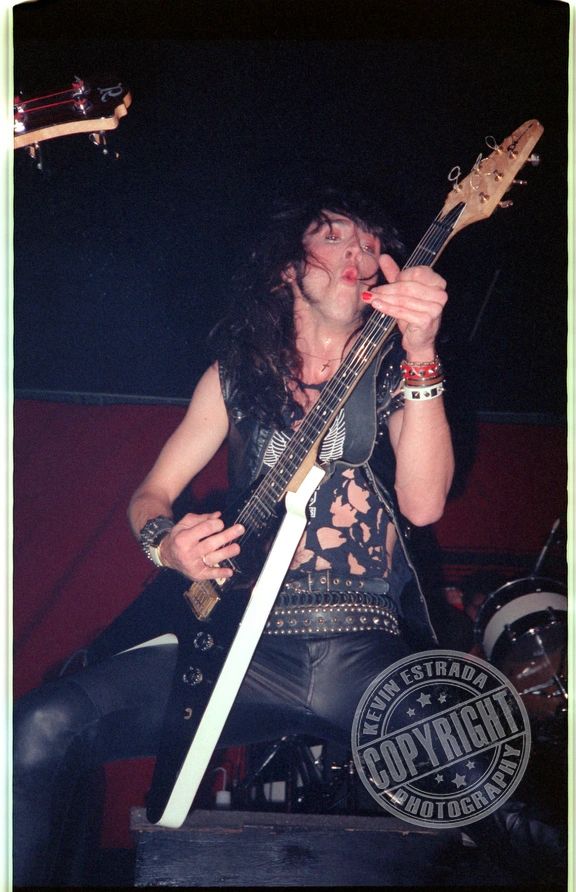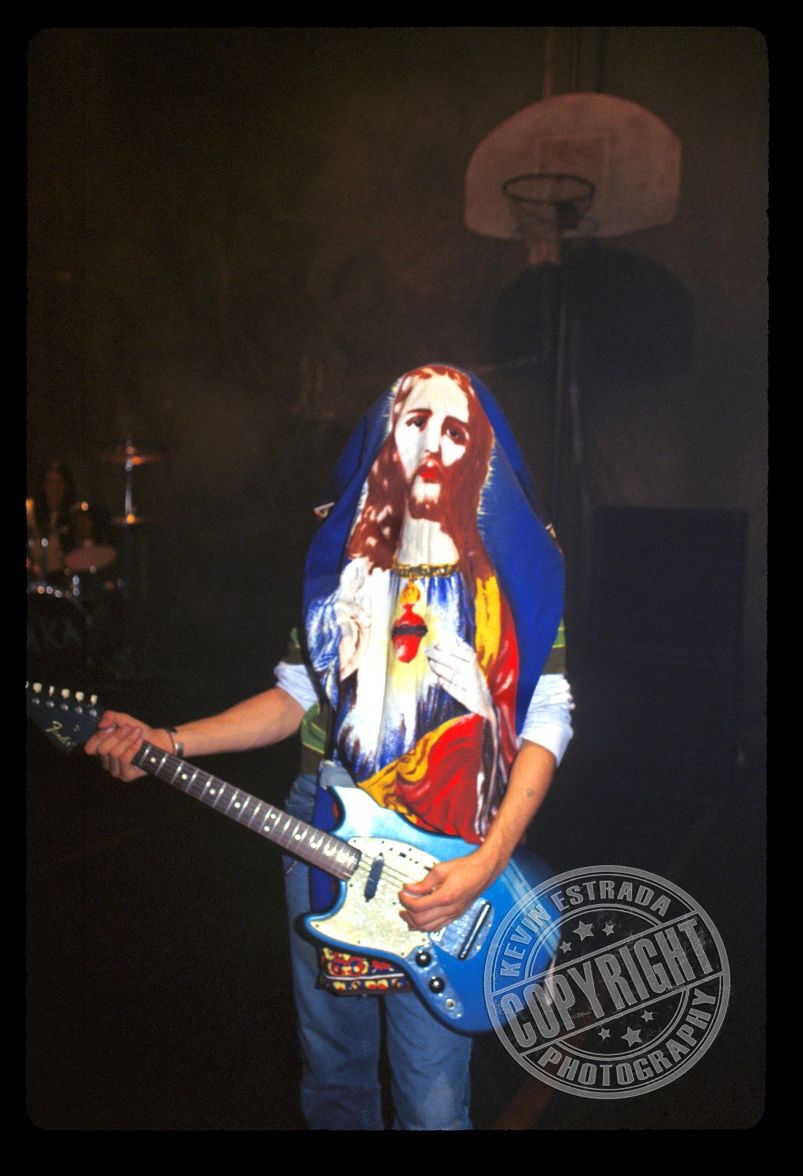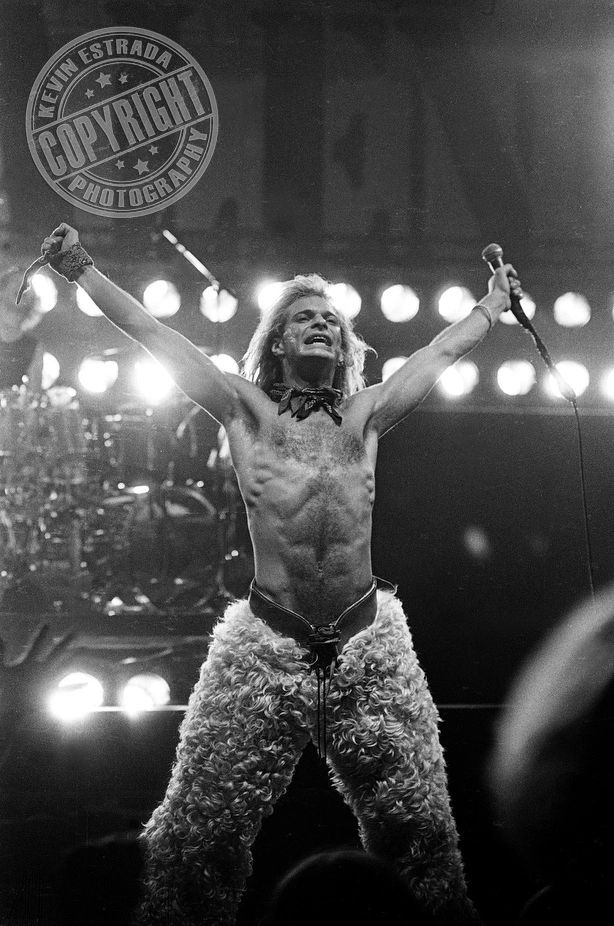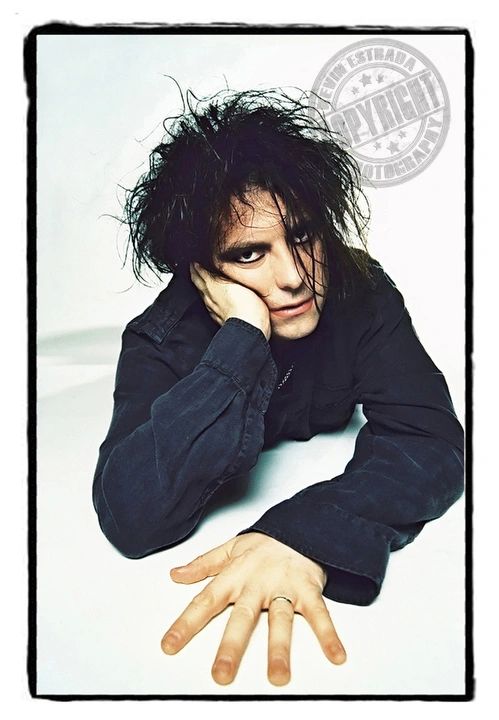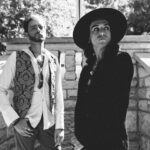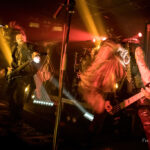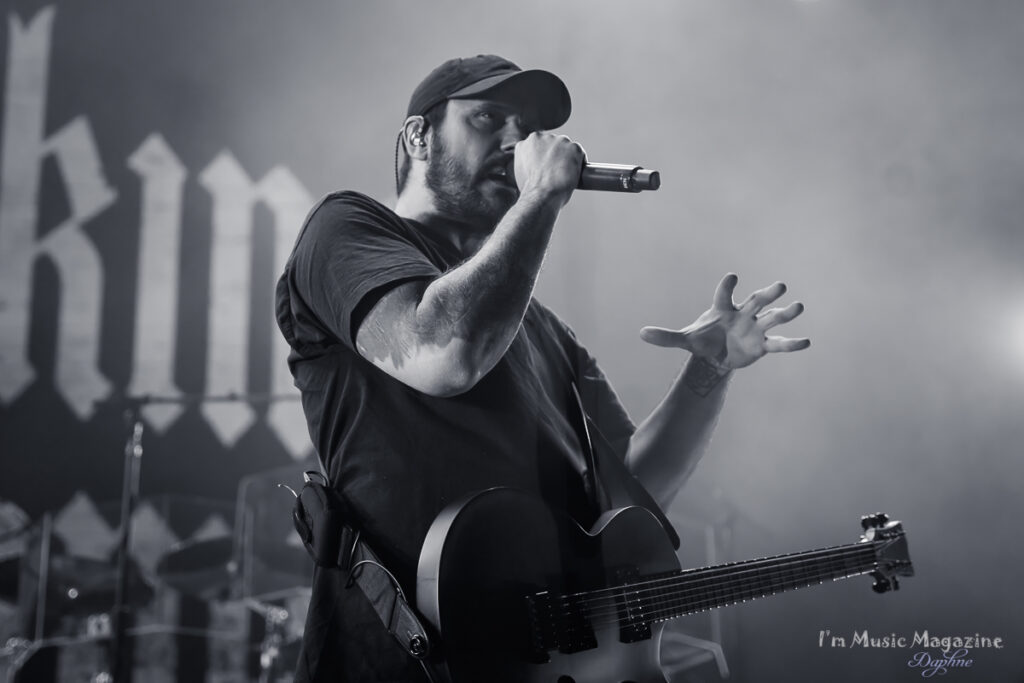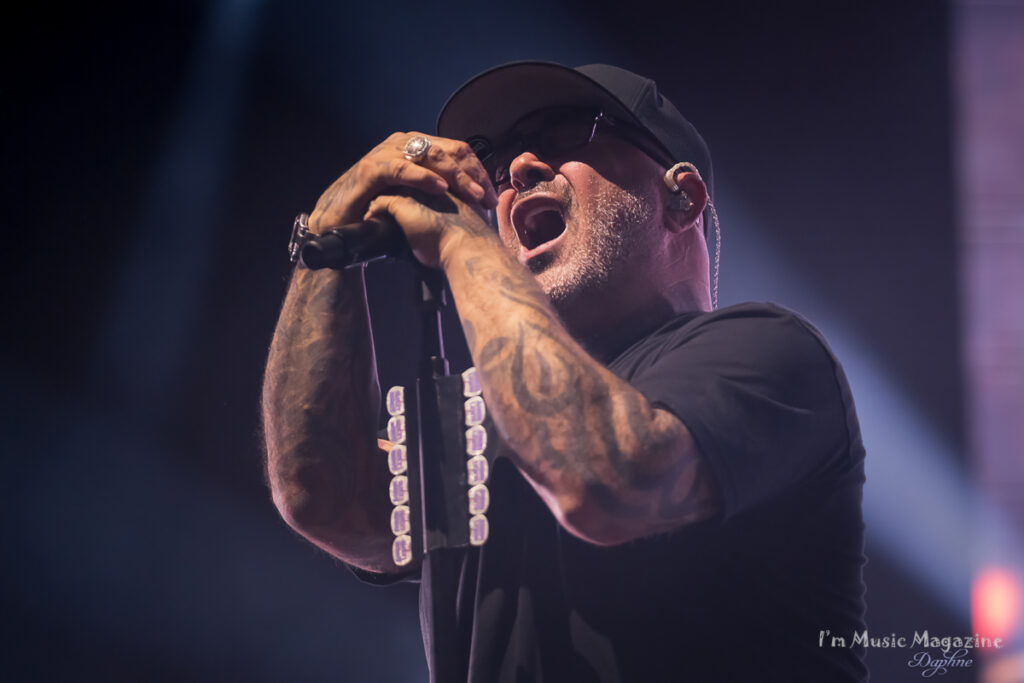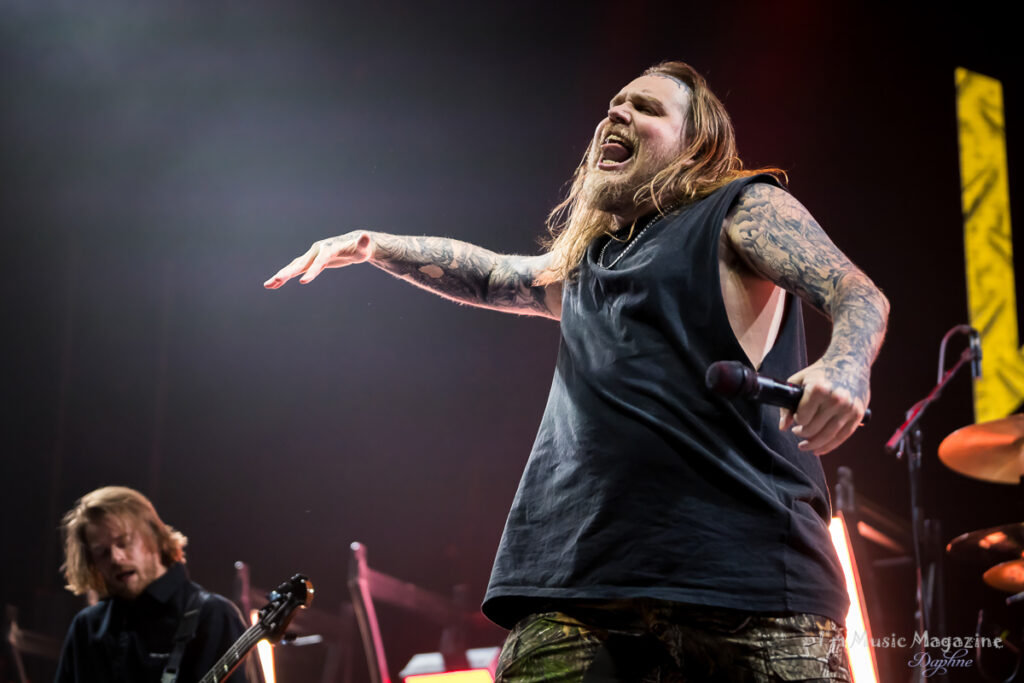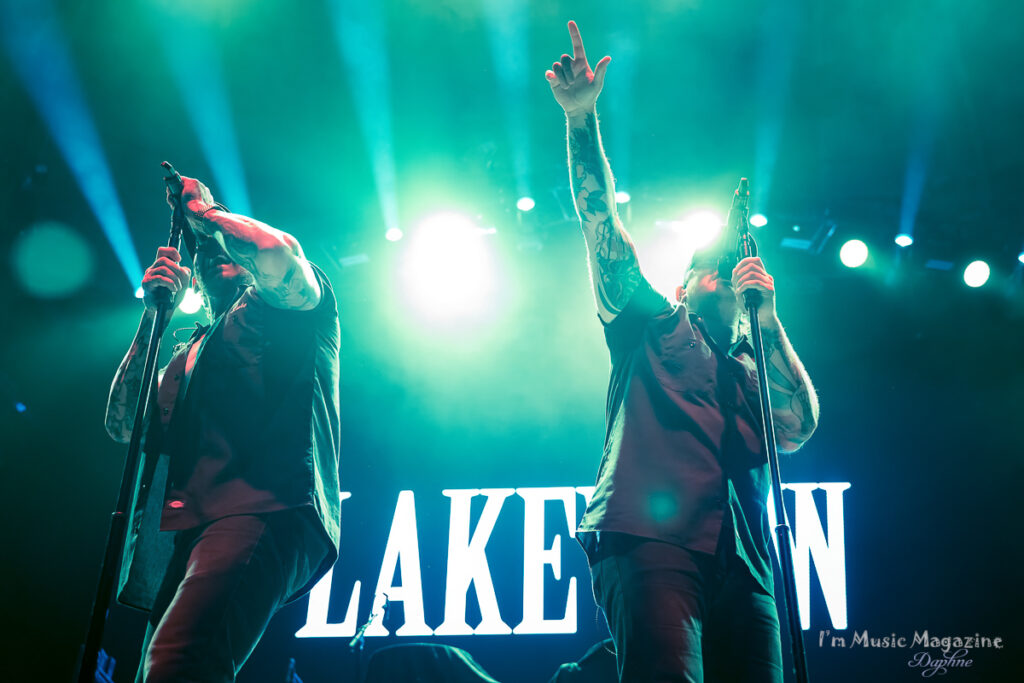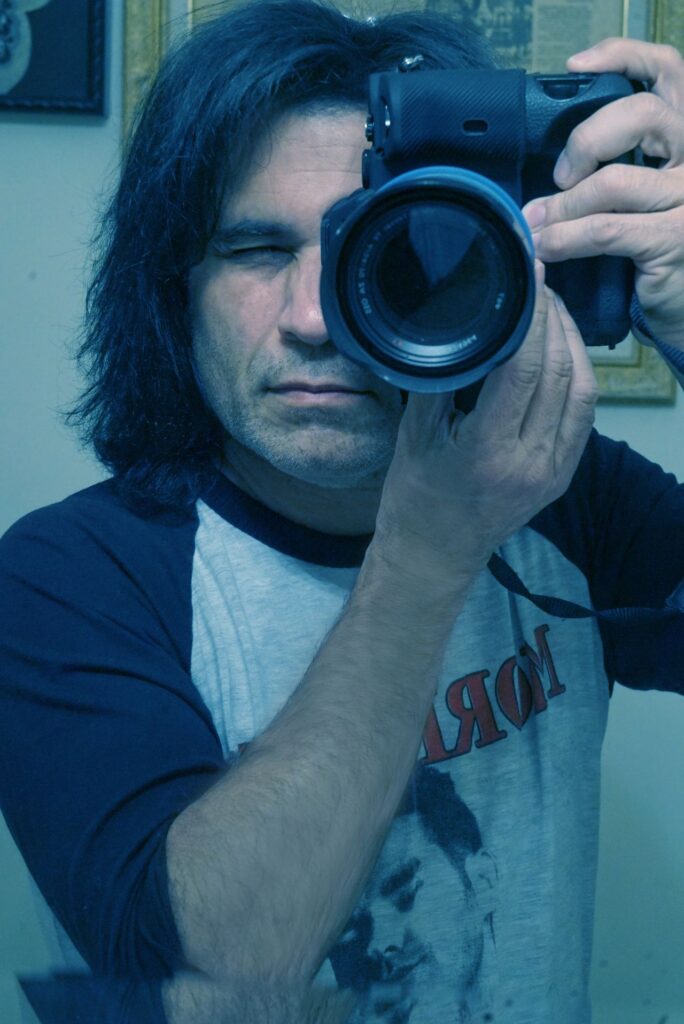
Kevin Estrada is a Rock Photographer and has snapped iconic photos of Nirvana, Van Halen, Jane’s Addiction, and The Cure, just to name a few. Kevin has created an amazing name for himself in the music business as a Rock Photographer, as an A&R Rep for record labels like Roadrunner Records, and he was the youngest photographer for CREEM Magazine in the 80’s and 90’s. I was lucky enough to interview him about his passion for music, his photography career, and his teenage stories of the ’80s L.A. music scene on the Sunset Strip that are featured in the new photo book/LP box set Bound for Hell: On The Sunset Strip.
Meesha Walden/I’m Music Magazine: I was reading your blog on your website and there is a post called “If You Can’t Shoot ‘Em… Draw ‘Em!” and there’s a drawing you did of David Lee Roth when you were a kid. It’s an amazing drawing! I didn’t know that you’re an incredible artist as well as a photographer.
Kevin Estrada: I drew those when I was a teenager. I drew my heroes, like Eddie Van Halen, Randy Rhoads, and David Roth. I used to draw a lot and was ccepted to art school in Pasadena at the Art Center, but my parents were afraid I would starve. Funny thing is, I ended up being a photographer and they still worried I was going to starve.
How did you get started in photography?
I started because I’m very sentimental, and I’ve held on to a lot of stuff from when I was a kid. I have all my ticket stubs and T-shirts from the shows I attended while growing up. I started shooting photos because I wanted to hold onto that memory from the concert. I could buy a T-shirt, or I could buy a tour program with lots of photos. That’s when I started liking the photographs. But I wanted something to hold onto from that specific show. I could go back to it and say, oh yeah, this is what it looked like, or this is what he was wearing, or this is what the stage looked like. That’s what made me think I should just take a camera to the concert and take photos. My brother was the one who wanted to be a photographer, had the camera, the dark room, and was printing photos all night. I never thought about being a photographer until I got into music. So, I started sneaking into my brother’s closet to take his Pentax K 1000 camera and his lenses into concerts and that’s how it all started.
There was this big festival called the US Festival in 1983. It was in San Bernardino, CA, a three-day festival. The second day was Heavy Metal Day. Quiet Riot, Motley Crue, Ozzy Osborne, Judas Priest, Triumph, Scorpions, and Van Halen played that day – what an incredible lineup! I snuck his camera into the show in a bag of potato chips. A big bag of Lay’s potato chips. During the huge festival, I somehow dented part of the lens on his camera. And when I got back home, he was so mad, he wouldn’t let me borrow his stuff again – looking back, I can’t blame him. That prompted my mother, who was always super supportive, to buy me my very first camera later that year – a Canon AE-1. I was already fueled and addicted to music photography by that time, so when my mother got me my first camera, that was my turning point.
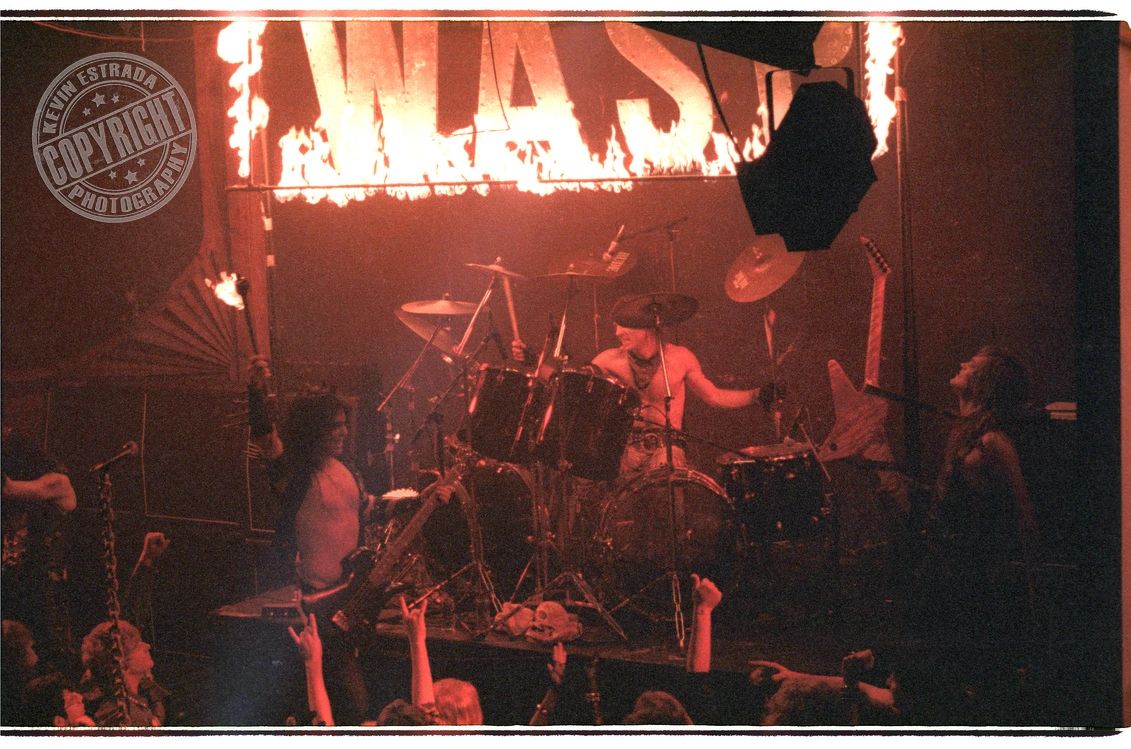
That’s awesome. And who were the first bands you photographed?
The bands that influenced me growing up were, Led Zeppelin and Black Sabbath, the hard rock genre of music. Then I started going to shows and seeing Van Halen play. They quickly became my favorite band. I started seeing them early on, and I never missed a tour. Then it was Van Halen and early Motley Crue around 1981. I saw all the L.A. local bands around that time – there were so many great bands. That’s when I really started flourishing as a photographer because I was sneaking my camera into Van Halen, Scorpions and Iron Maiden shows, but then I discovered that local band’s shows were much easier for me to walk in with my camera rather than having to tape it on my back and hide it. So, I started shooting all these local bands and it turned out all those local bands I was shooting were becoming big bands. All of a sudden, I had Ratt and Motley Crue photos who became huge arena bands. The way I used to sneak my camera was to duct tape it to the back of my neck. I’d wear a hoodie, the hoodie would cover the camera then I’d stick the lens on one of my friends’ necks or this girl that used to hang around with us would put it in her bra. I had this other friend who had big, metal hair like Dee Snyder from Twisted Sister and I could stick a massive lens in his hair. The collar of his jacket would hold it and then we’d cover his hair over it, and I’d stick rolls of film in there. That was my little team and we’d all be sneaking in pieces of my camera and then we’d get inside, and I’d put the camera together and take photos. My friend Rob would be on the lookout to make sure security didn’t see me. He’d tap me, and I’d duck down and hide when security was around.
I read on your blog that you got kicked out of a show. Was it at the Hollywood Palladium?
I got kicked out of all sorts of places. I got kicked out of the Palladium, The Palace, The Roxy, all over. Getting kicked out was pretty embarrassing. Not only embarrassing but you’re bummed because you spent money on a ticket and you’re waiting out there for your friends. They don’t come out; they don’t feel bad. They’re like, oh well, I’ll see you after the show.
Did anyone ever take the photos from you?
Yes, a couple of times. At the Palladium, this guy grabbed me and tried to open my camera and couldn’t do it. At a couple of shows, security did get it open and exposed the film. It just depended. Usually, they couldn’t figure out how to open the camera and just throw me out with the camera. Sometimes I’d wait, then come back in and say I had to go to the car and wait for a different guy at the door to let me in.
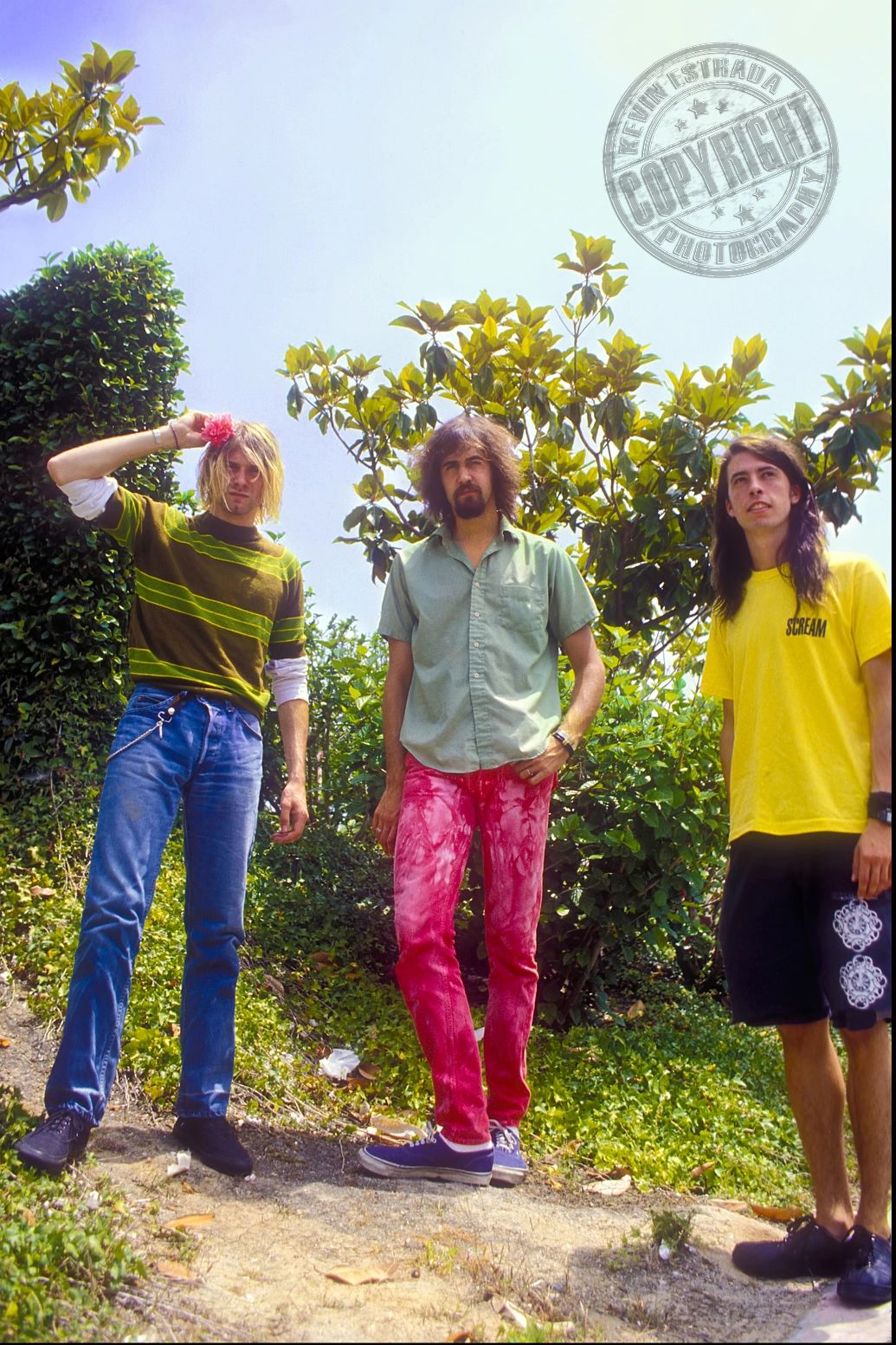
You learned all the tricks of the trade.
By any means necessary!
Who would you consider your mentor(s)?
I didn’t really have a mentor. There were photographers I admired that were shooting rock bands. Neil Preston, who photographed Led Zeppelin was the first Rock Photographer that captivated me – his Zeppelin images were so powerful and really spoke to me. I was around eight years old, and I would just stare at his photos – he made a really big impact on me and really fed my love for rock photography. I was also captivated by the KISS trading cards that came out when I was a kid – tons of amazing concert photos and beautiful portraits. It was like a huge portfolio to look through and to learn from. I would study those photos and look at the lighting and the poses. I used to look at them and say, I wish I could do that, I wish I took that photo. I guess you could say those were my early mentors, even though I never knew these photographers. I looked up to them and aspired to take photos as good as theirs. But I had to learn on my own – I didn’t have anyone to help me. It was just picking up a camera and figuring out what worked and what didn’t. Because I was sneaking the camera in, I couldn’t use a flash, so I had to learn how to shoot without a flash and I had to learn which lenses to use and when to use them. Everything was trial and error – and to top it off, back then it was all FILM, digital did not exist…so there were expenses and time involved in the learning process.
That’s incredible that you were self-taught. It’s very inspiring to listen to your process. And you can’t see the pictures immediately to check them.
Exactly. Luckily in high school, I took a photography class. I was developing the film and printing the photos at school, so I was saving money that way. In high school when the Scorpions or Judas Priest played a concert, the other kids from school would find me at my locker and say, hey, did you go to Judas Priest last night? Yeah. Did you take photos? Yeah. Then they’d come back to my locker a day or two later when I had my photos and I’d sell photos to them from my locker. So, I’d make a little money. Then a friend of mine said, you can probably make good money selling it to fans at shows. I started going to venues like the LA Forum and would arrive two or three hours before the show when people were lined up waiting to go in. I’d walk around with this little flip book, I still have one. I’d have pictures of Iron Maiden, Judas Priest, and Van Halen, etc with five or six pictures of each band and sell the photos for $1 a piece or six for $5. I’d end up anywhere with $30 to $80 and buy more film, get the film processed, and buy my tickets and T-shirts. That was my little money-making scheme when I was a kid.
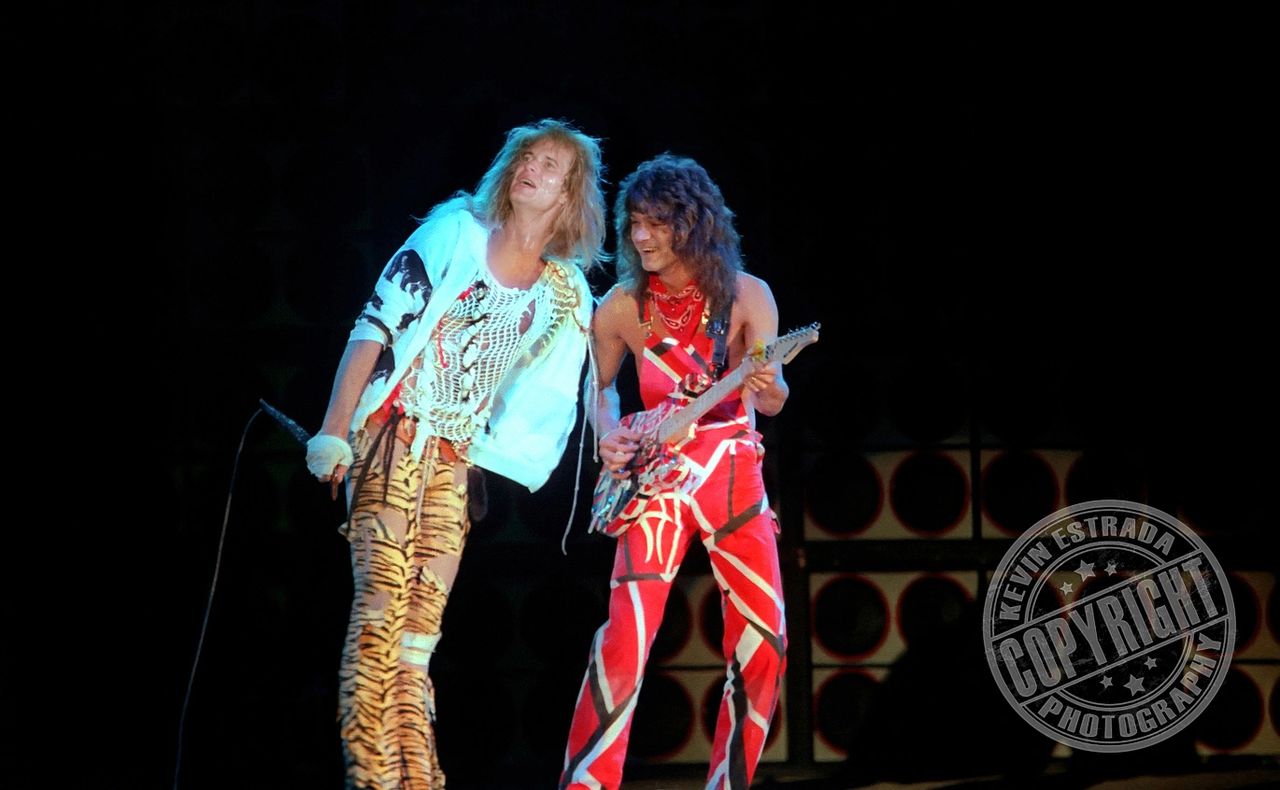
That’s genius. I know my favorite photo of yours is one of Kurt Cobain, with a Jesus shirt pulled over his face. Where was that photo taken?
It was taken at the video shoot for “Smells like Teen Spirit.” That’s one of my favorite photos too, it may be my favorite photo that I’ve taken. Of all the photos I have snapped, that’s the only photo I have hanging in my house and it’s a special one for me. The story behind the photo is when we were at the video shoot and the band was taking a break, Kurt found this tapestry in a storage closet at the sound stage and wrapped it around his neck and started running around like Superman. I don’t even think he noticed it had Jesus printed on it. I took it off his neck and I said, Kurt, look what’s on here. He started laughing and I placed it over his face and chest, and I said, check this out. I said, “you look like the punk rock Messiah.” Then he giggled and said, “Get my guitar.” He held his guitar and I snapped two frames of film and then they called him back to the set. He always loved that photo. There are only two frames that exist.
That is a really special story. And you were in the video too!
My friends and I were in the video. You can see us right from the beginning. It starts and we’re sitting in the bleachers. Kurt was in the editing room and made sure I got a couple of closeups in there. That was a great day. We were just there to have fun as big Nirvana fans. I’d gotten to know the band at that point, and I took some group shots of the band during a lunch break. We had no idea the video was going to be so iconic and change the whole music scene. It took over the music industry and we had no idea what we were in for. To this day people go, hey, are you in a Nirvana video? It’s 30 years later and people are still talking about it.
You’ve pretty much photographed everybody, but is there someone you haven’t photographed yet that you would like to?
There are a few. I know I’ve shot them live in concert, but I would really love to do portraits with U2. They are on my bucket list. If the Clash was still around, I would’ve wanted to do portraits with them too.
What’s one of your favorite stories that you’re willing to share? Stories from your times on the Sunset Strip or just in general in the music scene?
I have two Sunset Strip stories that come to mind. They were both at the Troubadour, which is a venue just off the Strip, but it was still considered to be part of the Sunset Strip. W.A.S.P. played there when they were still a club band. We all knew they were going to become a big band, but they would play these club shows at the Country Club, the Whiskey, and the Troubadour. They put on these shows that were meant for huge arena shows. They had this big sign that hung from the ceiling that spelled out W.A.S.P. At the end of the show, singer Blackie Lawless came out with a torch and he touched it to the letters, and they went up in flames. Lit up the entire club and it was so hot in there. I thought my skin was going to peel off my face. It was so dangerous now that I think about it, we all could have died in that place. There was one door to go in and out of that club. And the place was about 120 degrees with those flames burning. To this day there are burn marks on the ceiling from the flames from that night. There were no rules back then. It was the Wild West, and everybody was trying to outdo each other and make the biggest show ever. It was about the music, but it was also about how big the show could be.
My other story from the Strip is about trying to get into the Troubadour with my camera. At the Whiskey and the Roxy, I was able to tape the camera to my back and have friends help me sneak everything in. But the Troubadour had this guy at the door who was the ultimate security guy. He took his job way too seriously. And I was a kid, I’m 13 or 14 years old but I looked like I was like eight or nine because I’m a little guy. I was so unintimidating, but I’d walk through, and he'd frisk me like there was no tomorrow – and he’d catch me every time with the camera. So finally, I approached the owner of the club and worked out a deal with him. I asked, “what do I have to do to bring my camera in here?” He said, “you pay me $10 every time you bring the camera. I thought, “10 bucks??? That’s a lot of money! I’m paying seven bucks to come to the show. Now you’re gonna make me pay 10 bucks to bring my camera in?” But I said, “okay.” Then he said, “And you have to bring me contact sheets of all your photos every time you take photos.” I said, “okay.” I went to the next show after the deal, and I paid him $10. Then he brings out this form and tells me to write down my name, number and address. He said that way he could make sure I brought him his photos. I gave him $10 and wrote down a fake name, fake address, and fake phone number. I went to the club, and I took photos all night. And that was that W.A.S.P. show. Then I came back the next time and gave him a different name, a different number, and a different address and $10 and took photos. Next show I came back again with another name, another phone number, and another address. The guy never caught on and he never got his photos from me. All he ever got was 10 bucks each night with a fake name and address every time.
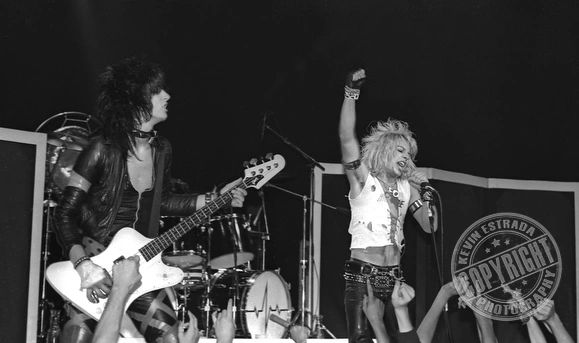
You’ve taken so many photos during your career, what was the process of selecting them for Bound to Hell: On the Sunset Strip photo and LP box set, and how did the project come about?
The whole box set was such a labor of love. We worked on it for a few years. It was a lot of talking about how we wanted to do the project, who would be involved in it, and which songs to include. It was probably a 5-year process in total. I put together a list of bands I thought should be on the box set and Adam Luksetich, fellow producer and Numero Group label rep, put his list together. Adam wanted me on the project because I was a part of the scene and had some good ideas of who should be included. We put a big list together, started going through it, and reached out to as many bands as we could. This was a great way to get their band name out there again and have a new generation of people hear the music. Some bands we reached out to had plans to put out their own compilation, some just didn’t want to participate, and some bands couldn’t be part of it due to legal reasons. If we could have every band we wanted, it would’ve probably been a five-record set. As soon as we started locking bands in, I started digging through all my photos and pulling as many photos of those bands as I had. That process took a long time; just going through the photos and choosing them. I ended up handing everything over to the label and letting them choose because I felt I was too close to the images, and they had an incredible vision for the layout of the book. I had my favorites, but I thought it would be good if they made their choices. More from a fan’s point of view than the photographer’s point of view. It was nice to see some different images going in the book that I wouldn’t have chosen. The art director had this cool concept of making everything red with a dark eerie vibe to it. The process was really fun and rewarding. There’s been so many Sunset Strip or LA metal compilations released, Adam and I wanted to do it right and pay respect to these bands because they broke down so many barriers. W.A.S.P., Black N Blue, Odin, Armored Saint, Sin, Steeler – there were no rules. They were creating the rules and creating a whole new music scene. The whole scene impacted and changed my life. To this day, everything I do, I think stemmed from that era, like becoming a photographer. If there wasn’t heavy metal, I don’t know what I would’ve been doing. I doubt I would've been taking a camera into a show, and I doubt I would’ve been even using a camera. I’d probably be working in some office somewhere. I really wanted to show respect to these bands and thank them for everything they did for me and all my friends and the whole scene. To this day, it’s still a big part of music, and a whole new generation of people discovering that music. There’s a love affair with the 80’s metal scene which shows that it was not just a fad, it was a huge part of music history. I was really proud that Adam wanted me to come on board and work on this box set with them and I think it came out great. I just wish we could have had another five or six of the bands that didn’t make it on there.
Are there plans to do Part 2 of the box set?
I’m hoping if it does well, you never know… we could do the 2.0. It was great getting to know a lot of these bands even more and collaborating with them in a different way. They knew me as that kid with the camera that was always at the shows. Now I was working with them on a box set, licensing their music, and working with them in the mastering lab. I had some of these guys coming over to my house on the weekends and we were dubbing their old cassette demos onto CDs at my house. Jamie from Black ‘N Blue was at my house on Sunday afternoons dubbing cassettes – it was such a great experience. I wanted this box set to be the best it could possibly be – not for me, but for the bands – this is their legacy. Like Stormer, this was the first time their music had ever been on vinyl. All they ever had were demo cassettes. They never had a record released, and this was the first time they heard their song on vinyl. One of the songs, “Savage Kind Of Girl” by VVSI was from a cassette that I recorded off of FM Radio on the KLOS local music radio show in 1983 or 1984. I had the cassette sitting in a box for 40 years. We mastered the song from that cassette, and they couldn’t believe how great it came out. Like I was saying earlier, I held onto all this stuff my whole life and if I hadn’t held onto that cassette, the song wouldn’t have been on the box set. I used to listen to the local music show on KLOS and they’d play all the local bands and I’d record them. Another local station, KMET, had the Mighty Metal Hour and I used to record those shows and listen over and over. Those shows were like my Bible for Heavy Metal every weekend.
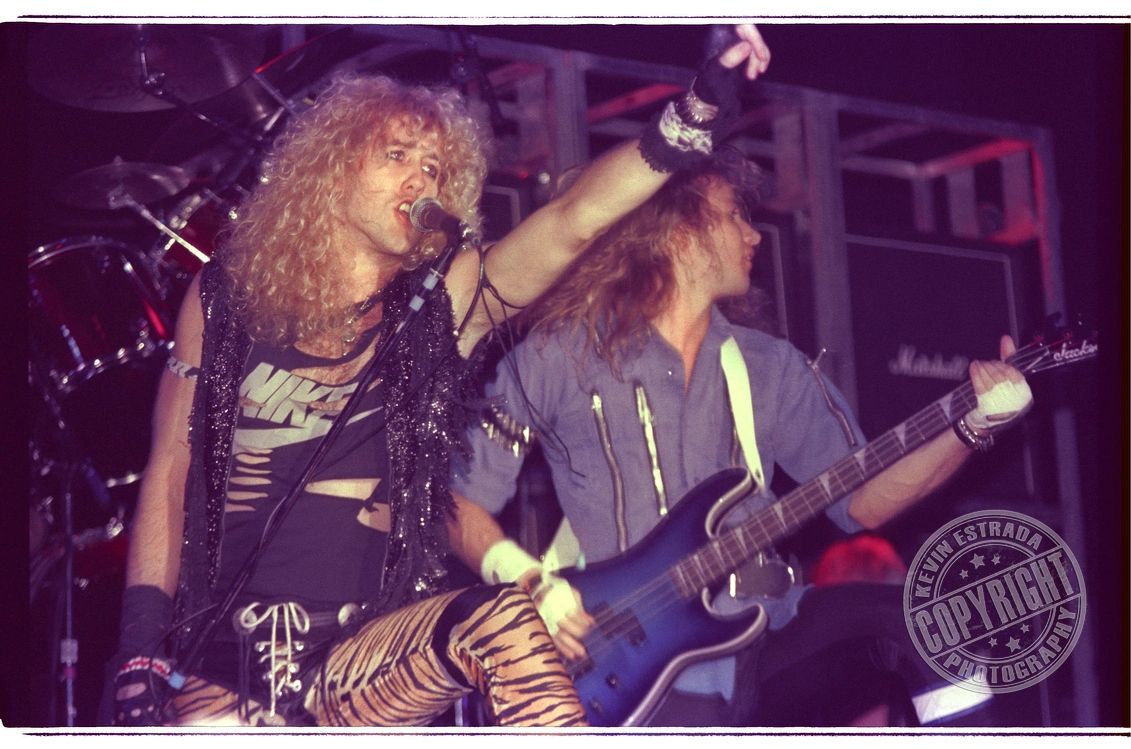
One of my favorite songs on Bound to Hell is Reddi Killowatt’s “Liquid Lady”. It’s so different and so cool.
Adam really went after that song. He really wanted Reddi Killowatt and I was aware of them because Reddi Killowatt used to play shows with Van Halen when Van Halen was a local band. Terry Kilgore was a guitar virtuoso. Eddie Van Halen and he would play together, write riffs together and teach each other these crazy ways of playing guitar. So that was a band we wanted to have on this project – not just the Van Halen’s of the world, but the bands that preceded Van Halen or played with them and that’s who Reddi Kilowatt was. They played so many shows with Van Halen in Pasadena, CA. Terry Kilgore later went on to play guitar with David Lee Roth on one of his solo tours.
It’s such a great song. And there’s no other music released by them, right?
As far as we know, that was it. They put out a 7” which was super limited because it was on his own label. I think we mastered the song from his 7”. A lot of the music at the time, the bands don’t even have the tapes. They don’t know what happened to them, they got ruined or they moved so many times they lost track of their tapes.
It’s a beautifully gritty, well-done book. The photos are incredible putting you right up front at the shows. It’s also fascinating to read the band bios accompanying the photos.
It’s written so well. Writer Katherine Turman did such a great job on the book. It’s a history lesson and she made it fun, not boring to read, and really captured that vibe. The book accompanies the music well and it’s fun to read and listen to the music at the same time. It takes you back into another time and world for sure! You also direct music videos and shoot photography for film and tv. How did you transition into that? I started directing music videos several years ago. I went to film school because of my passion for film. I made a short film that won awards at film festivals. Then I started directing music videos. I’ve directed videos for Serj Tankian from System of A Down and on the other side of the musical spectrum, I have directed videos for Nick Carter from the Backstreet Boys. I’m all over the place, from total brutal metal to colorful pop. I really enjoy going from still photos to directing moving pictures. It was an easy transition for me and made sense. Unfortunately, I got into directing music videos just as the music industry was imploding and budgets were falling apart in music. Videos went from $300,000to $10,000. I reinvented myself and fell into shooting photos for the film and TV industry. I recently shot the portraits for the Obi-Wan Kenobi streaming series. I have taken photos for Deadpool 2 and I just recently took photos for the New Guardians of the Galaxy 3 movie. I like it – I shoot rock bands, I shoot movies and I direct music videos and those are my three passions when it comes to visual arts. I’m blessed that I get to do what I love to do. I take photos for Lucas Films, Marvel, Netflix, Amazon Prime, Fox. Right now, I’m taking some photos on Rob Lowe’s show 911 Lone Star for Fox. One of the co-stars Ronan Rubenstein, who plays Rob Lowe’s son on the show is a big Nirvana fan, he discovered I have this other life shooting rock bands. It always leaks out that I’m the guy shooting Deadpool and also shot Nirvana. Actors love music and musicians love movies. It entices both sides. like the Slayer guys will be excited I'm shooting Deadpool, and the actors are excited I’m shooting Slayer. They never think I’m the same guy.
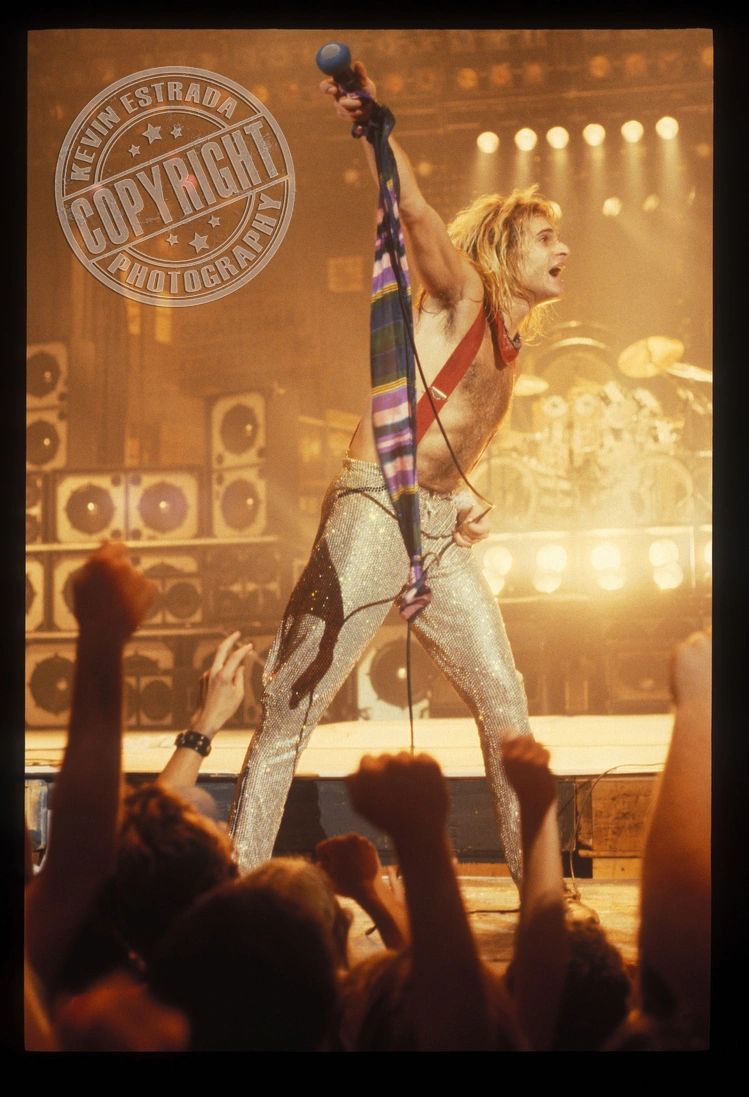
That’s really inspiring, you have all the dream jobs, Music, TV, and Film! Do you have any advice for photographers or anyone working in the music industry?
For photographers, shoot what you’re passionate about. I started off shooting rock bands because I love music. I was passionate about it. I’m still passionate about it. When I shoot a concert, my hands still get clammy. Like when we were at Judas Priest’s show recently, when the lights went down, my hands still got clammy beforehand. So as long as that happens, I know I’m still into it. My heart is still into it, it’s in my blood and I’m going to keep doing it until that clamminess goes away, maybe that’s when I retire, but I don’t think that’s going to happen anytime soon…or ever. That’s my main advice to a photographer, shoot something that you’re passionate about. I have a friend who loves Ansel Adams and has tons of prints and posters of his. And one day I said, “I can do that. How hard can shooting a mountain or a lake be?” Well, let me tell you, it’s not easy. Scenic photography – I am the worst! I realize it has to be in you. I’m not passionate about scenic photos and it showed in the photos I snapped. I learned that my thing is making people look interesting or making interesting people look bigger than life. I make rock stars look big and I make actors look big. They’re interesting people. I connect with them and that draws me to photograph them. I think it shows in my images as I try to get their personality across in the photos. My other piece of advice is just to keep knocking on doors. Don’t be shy or scared. Knock on doors and say, hey, I’m a photographer and this is what I do. Will you hire me? Or will you at least take a look at my photos? That's how I got my job shooting for CREEM Magazine. I was the youngest photographer shooting for CREEM Magazine in the 80s and 90’s. I landed that because I called the art director 52 days in a row. Every day, Monday through Friday, I only gave him weekends off. I never gave up…I got to know the office assistant very well. He finally called back and said, “is there some reason that I have a stack of messages from you on my desk every week?” and I said, “I just want you to look at my photos. I photograph rock bands. I want to be a rock photographer and I love the magazine.” Finally, he says, “if I look at your photos, will you stop calling me every day?” I went and showed him my photos and he loved them. The next day he says, “You want to go shoot the Ramones?” It made me realize that you just have to keep knocking on doors. The worst they can do is say no. It’s the same thing for music. The music has to be in your blood. You just have to find your angle. My angle is shooting rock bands and while I was doing A&R for record labels finding rock bands, like System of A Down, Static X, and Coal Chamber.
That’s great advice! Don’t give up on your dreams. Kevin, I appreciate you taking the time to do this interview. You have so many good stories and there’s so much more to talk about!
Interview by I’m Music Magazine Writer Meesha Walden
All photos: © Kevin Estrada / @KevinEstradaPhotography
